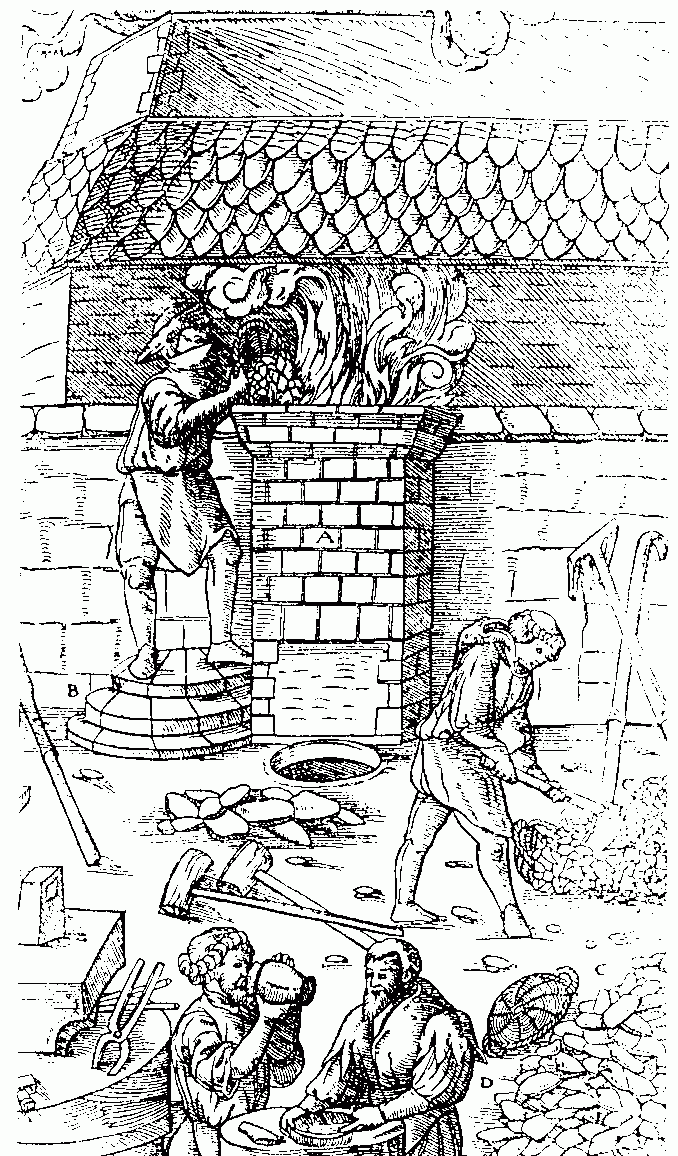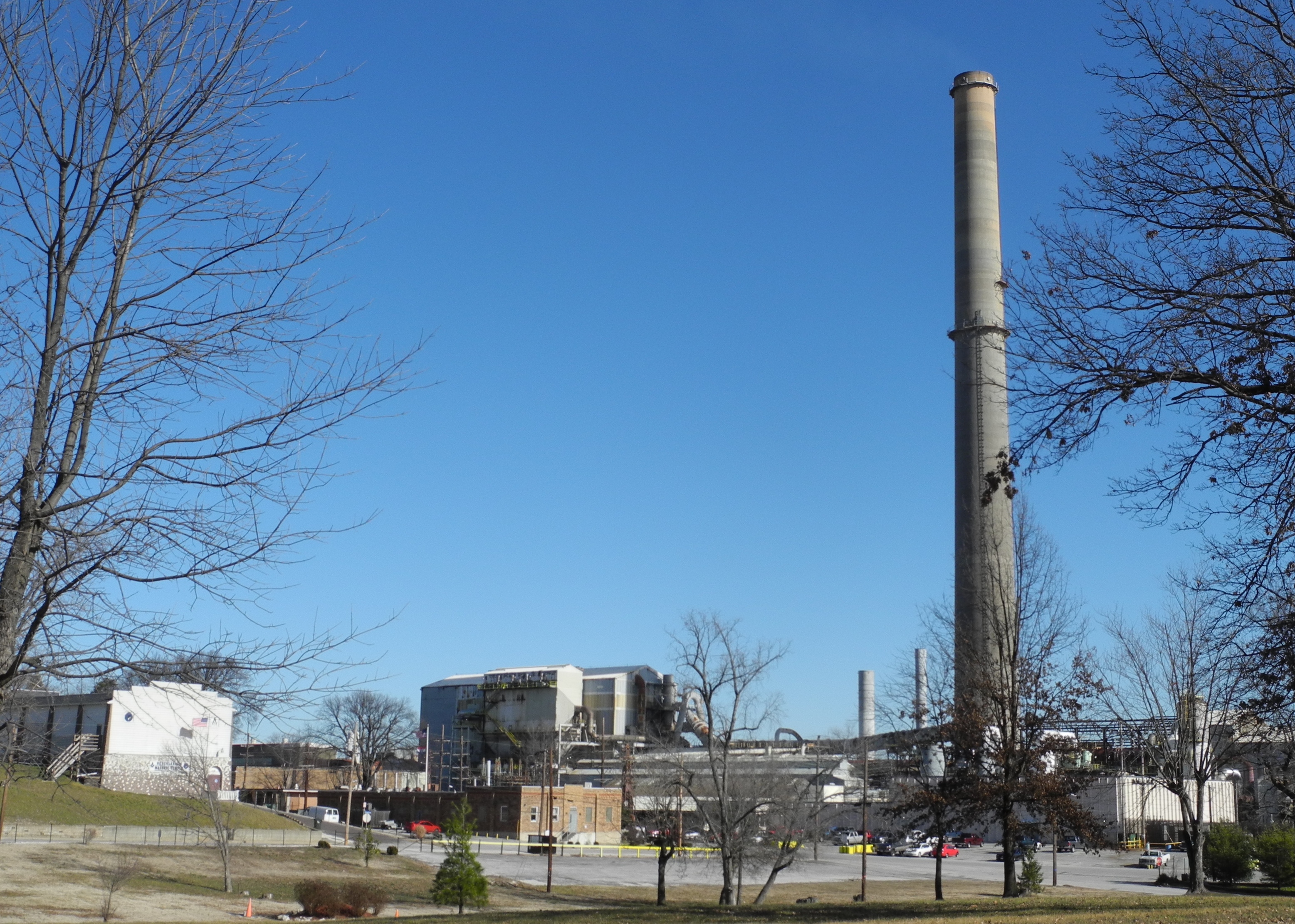|
Smelted
Smelting is a process of applying heat and a chemical reducing agent to an ore to extract a desired base metal product. It is a form of extractive metallurgy that is used to obtain many metals such as iron, copper, silver, tin, lead and zinc. Smelting uses heat and a chemical reducing agent to decompose the ore, driving off other elements as gases or slag and leaving the metal behind. The reducing agent is commonly a fossil-fuel source of carbon, such as carbon monoxide from incomplete combustion of coke—or, in earlier times, of charcoal. The oxygen in the ore binds to carbon at high temperatures, as the chemical potential energy of the bonds in carbon dioxide () is lower than that of the bonds in the ore. Sulfide ores such as those commonly used to obtain copper, zinc or lead, are roasted before smelting in order to convert the sulfides to oxides, which are more readily reduced to the metal. Roasting heats the ore in the presence of oxygen from air, oxidizing the ore and li ... [...More Info...] [...Related Items...] OR: [Wikipedia] [Google] [Baidu] |
Iron-making
Ferrous metallurgy is the metallurgy of iron and its alloys. The earliest surviving prehistoric iron artifacts, from the 4th millennium BC in Egypt, were made from meteoritic iron-nickel. It is not known when or where the smelting of iron from ores began, but by the end of the 2nd millennium BC iron was being produced from iron ores in the region from Greece to India,Riederer, Josef; Wartke, Ralf-B.: "Iron", Cancik, Hubert; Schneider, Helmuth (eds.): Brill's New Pauly, Brill 2009Early Antiquity By I.M. Drakonoff. 1991. University of Chicago Press. . p. 372 The use of wrought iron (worked iron) was known by the 1st millennium BC, and its spread defined the Iron Age. During the medieval period, smiths in Europe found a way of producing wrought iron from cast iron, in this context known as pig iron, using finery forges. All these processes required charcoal as fuel. By the 4th century BC southern India had started exporting wootz steel, with a carbon content between pig iron and ... [...More Info...] [...Related Items...] OR: [Wikipedia] [Google] [Baidu] |
Steel
Steel is an alloy of iron and carbon that demonstrates improved mechanical properties compared to the pure form of iron. Due to steel's high Young's modulus, elastic modulus, Yield (engineering), yield strength, Fracture, fracture strength and low raw material cost, steel is one of the most commonly manufactured materials in the world. Steel is used in structures (as concrete Rebar, reinforcing rods), in Bridge, bridges, infrastructure, Tool, tools, Ship, ships, Train, trains, Car, cars, Bicycle, bicycles, Machine, machines, Home appliance, electrical appliances, furniture, and Weapon, weapons. Iron is always the main element in steel, but other elements are used to produce various grades of steel demonstrating altered material, mechanical, and microstructural properties. Stainless steels, for example, typically contain 18% chromium and exhibit improved corrosion and Redox, oxidation resistance versus its carbon steel counterpart. Under atmospheric pressures, steels generally ... [...More Info...] [...Related Items...] OR: [Wikipedia] [Google] [Baidu] |
Zinc Smelting
Zinc smelting is the process of converting zinc concentrates ( ores that contain zinc) into pure zinc. Zinc smelting has historically been more difficult than the smelting of other metals, e.g. iron, because in contrast, zinc has a low boiling point. At temperatures typically used for smelting metals, zinc is a gas that will escape from a furnace with the flue gas and be lost, unless specific measures are taken to prevent it. The most common zinc concentrate processed is zinc sulfide,. which is obtained by concentrating sphalerite via froth flotation. Secondary (recycled) zinc material, such as zinc oxide, is also processed with the zinc sulfide.. Approximately 30% of all zinc produced is from recycled sources. Methods There are two methods of smelting zinc: the pyrometallurgical process and the electrolysis process. Both methods are still used. Both of these processes share the same first step: roasting. Roasting Roasting is a process of oxidizing zinc sulfide concentrat ... [...More Info...] [...Related Items...] OR: [Wikipedia] [Google] [Baidu] |
Copper Extraction
Copper extraction is the multi-stage process of obtaining copper from list of copper ores, its ores. The conversion of copper ores consists of a series of physical, chemical, and electrochemical processes. Methods have evolved and vary with country depending on the ore source, local environmental law, environmental regulations, and other factors. The copper smelters with the highest production capacity (metric tons of copper yearly) lie in China, Chile, India, Germany, Japan, Peru and Russia. China alone has over half of the world's production capacity and is also the world's largest consumer of refined copper. Precious metals and sulfuric acid are often valuable by-products of copper refining. Arsenic is the main type of impurity found in copper concentrates to enter smelting facilities. There has been an increase in arsenic in copper concentrates over the years since shallow, low-arsenic copper deposits have been progressively depleted. History Prehistory The Old Copper Compl ... [...More Info...] [...Related Items...] OR: [Wikipedia] [Google] [Baidu] |
Lead Smelting
Plants for the production of lead are generally referred to as lead smelters. Primary lead production begins with sintering. Concentrated lead ore is fed into a sintering machine with iron, silica, limestone fluxes, coke, soda ash, pyrite, zinc, caustics or pollution control particulates. Smelting uses suitable reducing substances that will combine with those oxidizing elements to free the metal. Reduction is the final, high-temperature step in smelting. It is here that the oxide becomes the elemental metal. A reducing environment (often provided by carbon monoxide in an air-starved furnace) pulls the final oxygen atoms from the raw metal. Lead is usually smelted in a blast furnace, using the lead sinter produced in the sintering process and coke to provide the heat source. As melting occurs, several layers form in the furnace. A combination of molten lead and slag sinks to the bottom of the furnace, with a layer of the lightest elements referred to as speiss, including arse ... [...More Info...] [...Related Items...] OR: [Wikipedia] [Google] [Baidu] |
Electrolysis
In chemistry and manufacturing, electrolysis is a technique that uses Direct current, direct electric current (DC) to drive an otherwise non-spontaneous chemical reaction. Electrolysis is commercially important as a stage in the separation of chemical element, elements from naturally occurring sources such as ores using an electrolytic cell. The voltage that is needed for electrolysis to occur is called the decomposition potential. The word "lysis" means to separate or break, so in terms, electrolysis would mean "breakdown via electricity." Etymology The word "electrolysis" was introduced by Michael Faraday in 1834, using the Greek language, Greek words "amber", which since the 17th century was associated with electrical phenomena, and ' meaning "dissolution". Nevertheless, electrolysis, as a tool to study chemical reactions and obtain pure chemical element, elements, precedes the coinage of the term and formal description by Faraday. History In the early nineteenth century, ... [...More Info...] [...Related Items...] OR: [Wikipedia] [Google] [Baidu] |
Aluminium
Aluminium (or aluminum in North American English) is a chemical element; it has chemical symbol, symbol Al and atomic number 13. It has a density lower than that of other common metals, about one-third that of steel. Aluminium has a great affinity towards oxygen, passivation (chemistry), forming a protective layer of aluminium oxide, oxide on the surface when exposed to air. It visually resembles silver, both in its color and in its great ability to reflect light. It is soft, magnetism, nonmagnetic, and ductility, ductile. It has one stable isotope, 27Al, which is highly abundant, making aluminium the abundance of the chemical elements, 12th-most abundant element in the universe. The radioactive decay, radioactivity of aluminium-26, 26Al leads to it being used in radiometric dating. Chemically, aluminium is a post-transition metal in the boron group; as is common for the group, aluminium forms compounds primarily in the +3 oxidation state. The aluminium cation Al3+ ... [...More Info...] [...Related Items...] OR: [Wikipedia] [Google] [Baidu] |
Aluminium Smelting
Aluminium smelting is the process of extracting aluminium from its oxide, alumina, generally by the Hall-Héroult process. Alumina is extracted from the ore bauxite by means of the Bayer process at an alumina refinery. This is an electrolytic process, so an aluminium smelter uses huge amounts of electric power; smelters tend to be located close to large power stations, often hydro-electric ones, in order to hold down costs and reduce the overall carbon footprint. Smelters are often located near ports, since many smelters use imported alumina. Layout of an aluminium smelter The Hall-Héroult electrolysis process is the major production route for primary aluminium. An electrolytic cell is made of a steel shell with a series of insulating linings of refractory materials. The cell consists of a brick-lined outer steel shell as a container and support. Inside the shell, cathode blocks are cemented together by ramming paste. The top lining is in contact with the molten metal a ... [...More Info...] [...Related Items...] OR: [Wikipedia] [Google] [Baidu] |
TVA Phosphate Smelting Furnace
The Tennessee Valley Authority (TVA) is a State-owned enterprises of the United States#List of partially or wholly federally owned enterprises, federally owned electric utility corporation in the United States. TVA's service area covers all of Tennessee, portions of Alabama, Mississippi, and Kentucky, and small areas of Georgia (U.S. state), Georgia, North Carolina, and Virginia. While owned by the Federal government of the United States, federal government, TVA receives no taxpayer funding and operates similarly to a private for-profit company. It is headquartered in Knoxville, Tennessee, and is the sixth-largest power supplier and largest public utility in the country. The TVA was created by United States Congress, Congress in 1933 as part of President Franklin D. Roosevelt's New Deal. Its initial purpose was to provide navigation, flood control, electricity generation, fertilizer manufacturing, Urban planning, regional planning, and economic development to the Tennessee Valle ... [...More Info...] [...Related Items...] OR: [Wikipedia] [Google] [Baidu] |
Mindat
Mindat may refer to: Places * Mindat District, a district in Chin State, Myanmar (Burma), consisting of two townships and many villages ** Mindat Township, Myanmar *** Mindat, Chin State, a town in Chin State, Myanmar, administrative seat of Mindat Township Other uses * Mindat, alternative name for the Kʼchò language in Myanmar * Mindat Min, a Burmese prince * Mindat.org, an online mineralogy database {{dab, geo ... [...More Info...] [...Related Items...] OR: [Wikipedia] [Google] [Baidu] |
Karabash Copper Smelter
Karabash may refer to: Places * Karabash Reservoir, a freshwater reservoir in the Republic of Tatarstan, Russia * Karabash (inhabited locality), several inhabited localities in Russia People *Dmytro Karabash, one of the recipients of the 2007 Van Amringe Mathematical Prize Other *Karabaş (''Karabash''), alternative name for Anatolian Shepherd Dog, a dog breed {{Disambiguation, geo, surname ... [...More Info...] [...Related Items...] OR: [Wikipedia] [Google] [Baidu] |




